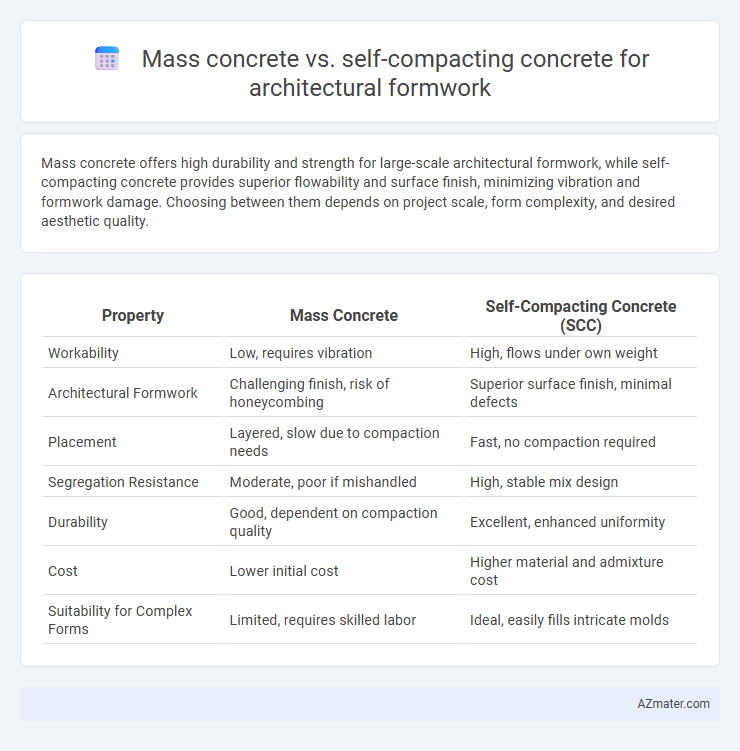Mass concrete offers high durability and strength for large-scale architectural formwork, while self-compacting concrete provides superior flowability and surface finish, minimizing vibration and formwork damage. Choosing between them depends on project scale, form complexity, and desired aesthetic quality.
Table of Comparison
| Property | Mass Concrete | Self-Compacting Concrete (SCC) |
|---|---|---|
| Workability | Low, requires vibration | High, flows under own weight |
| Architectural Formwork | Challenging finish, risk of honeycombing | Superior surface finish, minimal defects |
| Placement | Layered, slow due to compaction needs | Fast, no compaction required |
| Segregation Resistance | Moderate, poor if mishandled | High, stable mix design |
| Durability | Good, dependent on compaction quality | Excellent, enhanced uniformity |
| Cost | Lower initial cost | Higher material and admixture cost |
| Suitability for Complex Forms | Limited, requires skilled labor | Ideal, easily fills intricate molds |
Understanding Mass Concrete and Self-Compacting Concrete
Mass concrete involves large volumes of concrete poured continuously to achieve structural integrity, characterized by low heat of hydration and minimal reinforcement, ideal for heavy foundational elements in architectural formwork. Self-compacting concrete (SCC) flows under its own weight without mechanical vibration, offering superior surface finish and intricate detail replication in architectural formwork due to its high deformability and segregation resistance. Understanding the distinction enhances selection for projects requiring either robust structural mass or precise, high-quality surface aesthetics.
Key Properties of Mass Concrete
Mass concrete is characterized by its high volume and low permeability, providing excellent thermal stability and resistance to cracking due to temperature gradients. Its low slump and high density require careful curing to prevent thermal stress, making it ideal for large-scale structural elements where strength and durability are prioritized. Unlike self-compacting concrete, mass concrete demands mechanical vibration compaction and longer setting times to ensure uniformity and structural integrity in architectural formwork applications.
Essential Characteristics of Self-Compacting Concrete
Self-compacting concrete (SCC) offers superior flowability and excellent filling ability, enabling it to effortlessly fill complex architectural formwork without segregation or the need for mechanical vibration. Key characteristics include high deformability, stability against bleeding, and uniform consistency, which ensure smooth surface finishes and intricate detail reproduction in architectural elements. Compared to mass concrete, SCC enhances durability and reduces labor costs while maintaining structural integrity in intricate formwork designs.
Strength and Durability Considerations
Mass concrete offers high compressive strength and excellent durability due to its low water-cement ratio and dense microstructure, making it suitable for large architectural formwork requiring robust load-bearing capacity. Self-compacting concrete (SCC), with its superior flowability and segregation resistance, ensures uniform strength and enhanced surface finish, minimizing voids and defects that compromise durability. For architectural formwork, SCC provides better long-term performance in complex shapes and thin sections, while mass concrete excels in massive, monolithic structures demanding high structural integrity.
Workability in Architectural Formwork Applications
Mass concrete exhibits limited workability, often requiring mechanical vibration to eliminate air pockets and ensure proper compaction in architectural formwork applications. Self-compacting concrete (SCC) offers superior flowability and filling ability, enabling it to pass through complex formwork geometries without segregation or the need for external vibration. The enhanced workability of SCC results in improved surface finish, reduced labor costs, and higher precision in intricate architectural designs.
Formwork Pressure and Construction Techniques
Mass concrete typically exerts lower formwork pressure due to its slower placement rate and higher viscosity, allowing for more traditional, robust formwork systems in architectural applications. Self-compacting concrete (SCC) generates higher lateral formwork pressure because of its fluidity and rapid flow, necessitating the use of reinforced formwork with precise construction techniques to prevent deformation. Understanding these pressure differences is crucial for selecting appropriate formwork materials and ensuring structural integrity during the casting of complex architectural shapes.
Surface Finish and Aesthetic Outcomes
Mass concrete often presents challenges in achieving smooth, uniform surfaces due to limitations in flow and compaction, leading to potential voids and surface blemishes that impact architectural formwork aesthetics. Self-compacting concrete (SCC) offers superior flowability and fills intricate formworks effortlessly, delivering high-quality surface finishes with minimal defects, enhancing the visual appeal of architectural elements. Its ability to produce consistent, void-free surfaces reduces the need for remedial treatments, making SCC a preferred choice for complex designs requiring precision in aesthetic outcomes.
Curing Requirements and Thermal Effects
Mass concrete requires extended curing periods to manage hydration heat and prevent thermal cracking, making temperature control critical in architectural formwork applications. Self-compacting concrete (SCC) exhibits lower heat generation due to optimized mix design and fine aggregate content, reducing thermal gradients and shrinkage risks during curing. Proper curing of SCC enhances surface finish quality and dimensional stability in complex architectural formwork without the intensive thermal management needed for mass concrete.
Cost Implications and Resource Efficiency
Mass concrete typically demands less sophisticated formwork and lower initial material costs, but increased labor and curing time can elevate total expenses. Self-compacting concrete reduces labor intensity and enhances finish quality by effortlessly flowing into complex architectural formwork, potentially lowering long-term costs despite higher material prices. Resource efficiency favors self-compacting concrete due to minimized waste, reduced rework, and faster construction cycles, optimizing both time and materials.
Best Use Cases for Architectural Formwork Applications
Mass concrete is best suited for architectural formwork requiring substantial structural support and thermal mass, such as large retaining walls or foundational elements, due to its low slump and high-density properties. Self-compacting concrete excels in intricate architectural formwork with complex shapes and fine surface finishes, offering superior flowability and minimal vibration, ideal for detailed facades or precast panels. Selecting between these concretes depends on the formwork complexity and aesthetic demands, ensuring optimal durability and appearance in architectural projects.

Infographic: Mass concrete vs Self-compacting concrete for Architectural formwork
 azmater.com
azmater.com